Cauliflower Chickpea Curry Stew
This Cauliflower Chickpea Curry Stew is an easy option for Meatless Monday or simply a delicious plant-based meal for any day of the week! It comes together in less than 30 minutes and makes a batch large enough for the whole family!
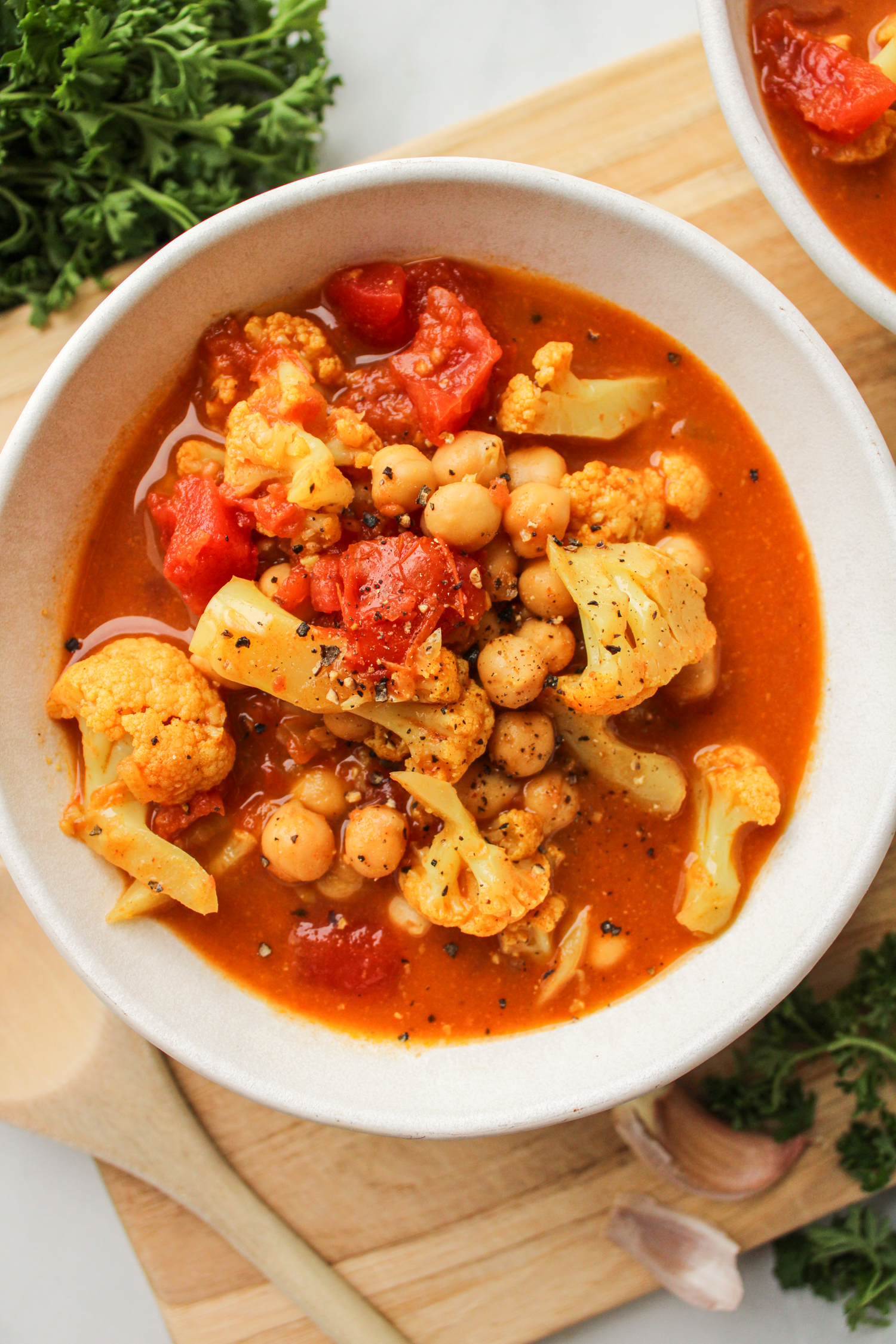
Originally posted January 20, 2022. Updated January 27, 2025.
Why you should try this Cauliflower Chickpea Curry Stew
It’s important to note that this is, by no means, an authentic curry recipe. This is my fun and easy way to combine a variety of foods with curry powder and complimentary spices to make a super quick weekday meal.
One of my favourite things about this recipe is how easy it is. It may look a bit intimidating with the number of spices and seasonings, but once you have them stocked, you are set for a while! When you’re short on time and energy is running low, this stew should be your go-to.
Another benefit is the amount that this recipe makes. Cook it to feed a hungry family or use it for several leftovers for yourself.
It is also relatively cost effective and freezer-friendly. Since it contains mostly canned goods, limited fresh produce and no meat, it’s a pretty inexpensive way to get a meal on the table. Plus, if you want to prepare it in advance and pop it in the freezer, save it for a cold and lazy day, to then just thaw it when you’re ready to enjoy it.
Ingredients needed
Here’s what you need for this Cauliflower Chickpea Curry:
- Cauliflower
- Chickpeas
- Diced tomatoes
- Lite or low fat coconut milk
- Vegetable broth
- White onion
- Garlic
- Tomato paste
- Garlic cloves
- Curry powder, cumin, paprika, chili powder, ginger, salt and pepper
- Olive oil for coating the pot
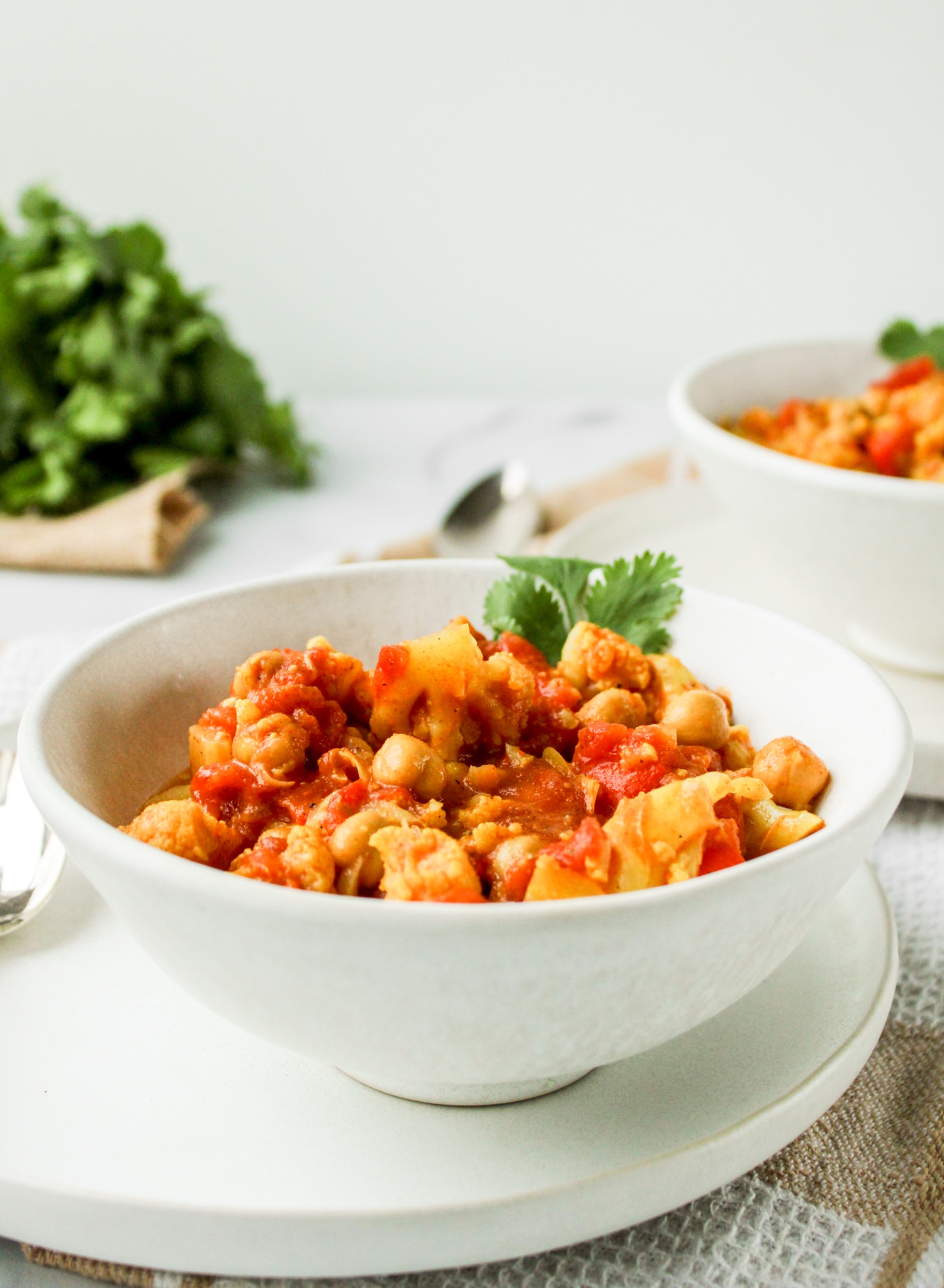
Substitutions and add-ins
If you don’t have a few of the recommended ingredients, or if you prefer substitutions, here is a list of alternative ingredients and add-ins you may prefer:
- White beans, lentils, other legumes
- If you prefer an alternative bean to chickpea, consider adding white beans or lentils instead. Just make sure to drain and rinse the beans to remove the sodium before adding them to the stew. You could also cook your own beans at home and skip the canned option.
- Chicken or beef stock
- You can easily swap out vegetable stock for either of these options! However, keep in mind that this substitution would result in a non-vegetarian meal.
- Full fat coconut milk
- I prefer to use low fat or lite coconut milk because it contains less saturated fat compared to full fat coconut milk. However, if this isn’t a concern for you and you would rather a creamier stew, you can use a full fat product.
- Red bell pepper
- Adding a bell pepper when the cauliflower is added would be a great way to increase the vitamin C content.
- Lime juice
- This stew already provides an acidic undertone with the tomatoes but if you would like a fresh citrusy bite, feel free to add a squeeze of fresh lime juice when serving.
- Fresh cilantro, parsley or basil
- I love to top this stew with a fresh herb. Feel free to choose your favourite.
How to make Cauliflower Chickpea Curry Stew
This stew can be made in less than 30 minutes! Here are the steps:
- In a large pot over medium heat, add the olive oil (or coconut oil, if you prefer), minced garlic and chopped onion and sauté for roughly 2-3 minutes or until the garlic and onion become fragrant.
- Next, add the chopped cauliflower, curry powder, cumin, paprika, chili powder and fresh ginger and stir until the cauliflower is coated in the seasonings.
- Now for the liquid. Pour in the coconut milk, diced tomatoes, vegetable broth and tomato paste. Stir until this is all combined. Cover the pot, then bring the mixture to a boil and then reduce the heat to low and simmer for about 10 minutes, or until the cauliflower is fully cooked and can be pierced easily with a knife or fork.
- Stir in the drained and rinsed chickpeas and season with salt and pepper. Serve the stew as is or over rice. Feel free to top with fresh parsley or cilantro and enjoy!
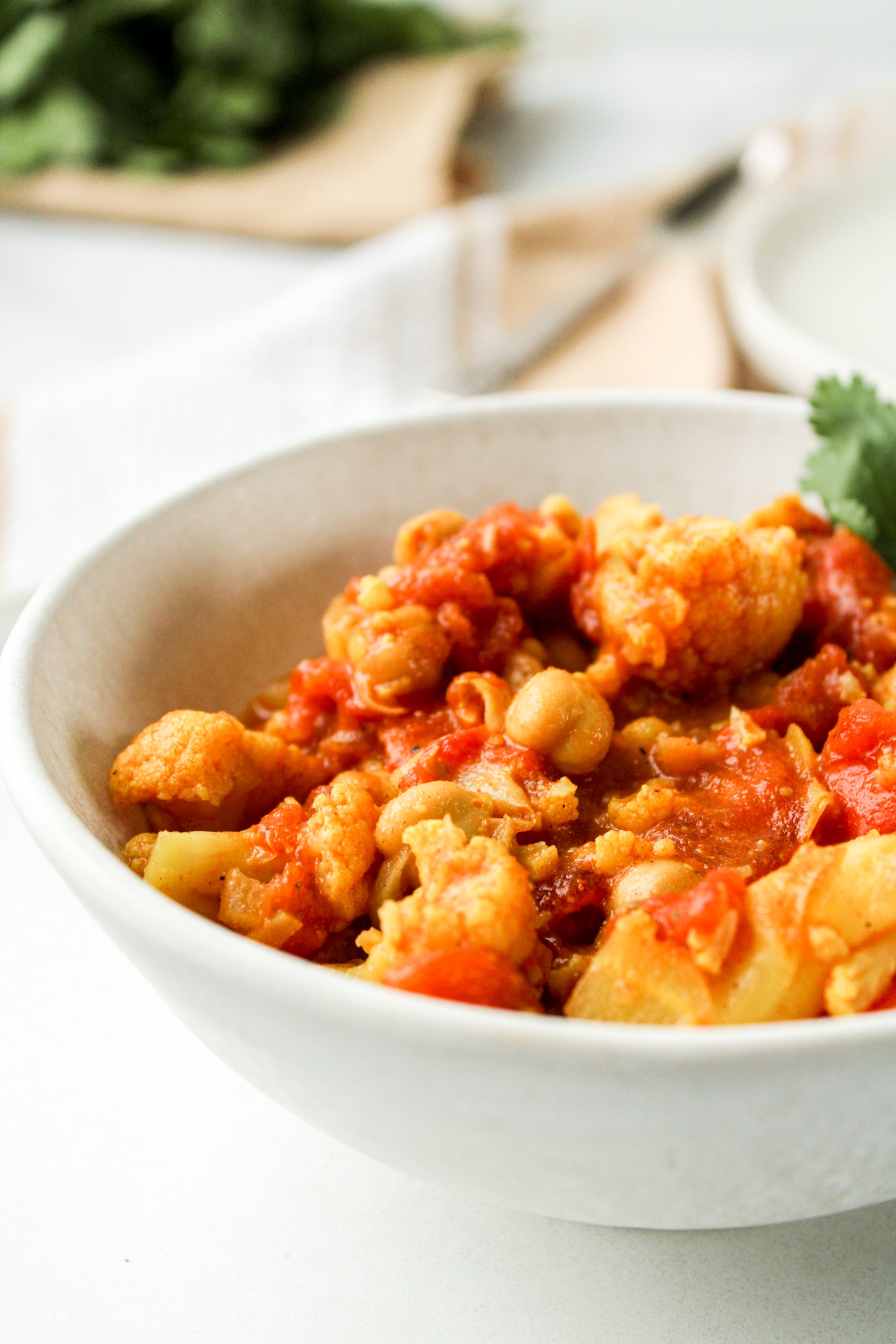
How to serve Cauliflower Chickpea Curry
This Cauliflower Chickpea Curry is absolutely delicious when enjoyed as is! However, I also love to serve it on top of warm white or brown rice for coziness. The rice also soaks up some of the liquid of the stew, so you get a variety of flavours and texture in every bite!
Don’t forget to season with extra salt and pepper, if needed. Finishing it off with fresh herbs, like cilantro, basil or parsley really takes it to the next level. I can’t wait for you to try it!
Storing and freezing
One of my favourite things about making big batches of stew is that it’s the perfect thing to keep in the freezer. It makes busy weekdays in the fall and winter so much easier when dinner is already made and just needs to be reheated. Here’s how to store and freeze this cauliflower curry stew.
If you plan to eat the stew within 3-4 days, allow it to fully cool before transferring it to an airtight container. You can then keep it in the fridge for up to 4 days.
To reheat the stew from the fridge, you can use the microwave or stove. If using the microwave, place your portion of stew in a microwave-safe bowl and heat in 30 second increments, stirring in between each one. Continue until the stew reaches your desired temperature.
If you prefer using the stove, add the stew to a small saucepan and heat on medium-high heat for 5-7 minutes, or until the stew reaches your ideal temperature.
If you want to freeze it for busy days coming up in the season, again, allow it to fully cool before transferring it to an airtight container. You could also use an empty and clean yogurt container. Don’t forget to label the container so you don’t forget what it is! Place it in the freezer and store it for up to 3-4 months.
Reheating stew from frozen
Here are a few methods you can use to reheat frozen chickpea cauliflower curry:
Take the stew out of the freezer the night before and place it in the fridge to thaw out overnight. It’s helpful to put the container on top of a plate or in a large bowl so that it catches the excess liquid when it thaws.
Or take the stew out of the freezer 1 hour before eating and place it in a large pot or container that’s filled with hot water (I’ll often do this in the smaller side of my sink). After 10-20 minutes, the hot water will thaw the outside layer of stew, making it easier to transfer the stew to a pot. Place this pot on low heat with the lid on and cook until completely thawed and warmed. Make sure you stir it every 5-10 minutes so the stew doesn’t burn. This can take around 30 minutes, depending on the size of the frozen stew.

Nutritional benefits
This Cauliflower Chickpea Curry Stew not only tastes delicious, but packs a ton of nutrients and health benefits!
- Cauliflower: rich in fibre, omega-3 fatty acids (surprisingly!), B vitamins, vitamin C and other minerals.
- Chickpeas: rich in plant-based protein, fibre, B vitamins, folate and manganese.
- Canned tomatoes: rice in fibre, some B vitamins, vitamin A, vitamin C, iron and other minerals.
In just three of the ingredients of this recipe, you are providing your body with so many beneficial nutrients! And doing so in a way that satisfies your taste buds and appetite. Yes please!
Dietary considerations
As a dietitian I love to create recipes that fit a variety of dietary needs. This Cauliflower Chickpea Curry is already vegetarian, vegan, dairy free, lactose free, gluten free and nut free!
I hope you love this cozy and filling plant-based meal!
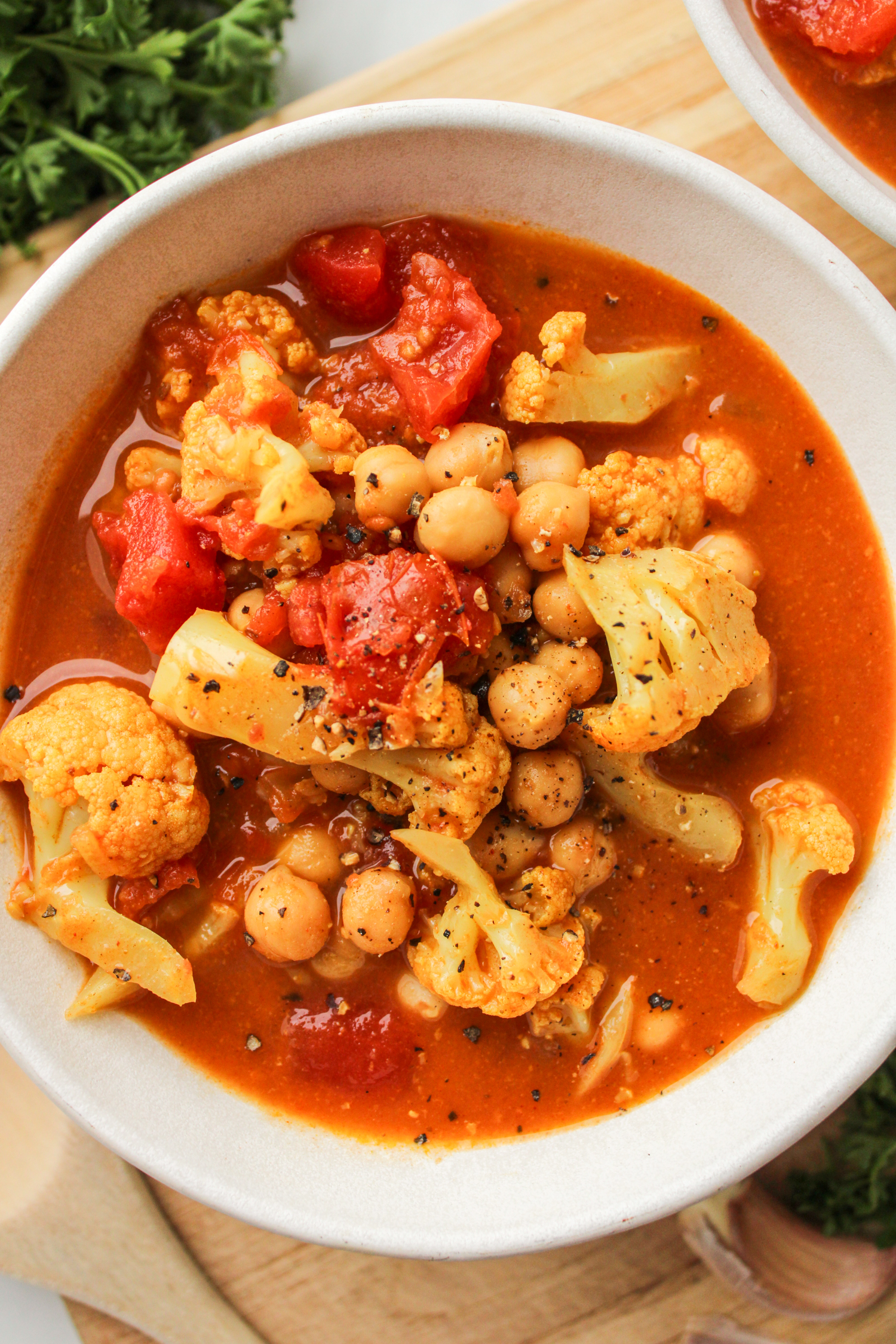
More plant-based dinner recipes:
- Dill Falafel Rice Bowls
- Easy Vegetarian Chili
- Sweet Potato Cashew Curry (Vegan)
- Tofu Burrito Bowls with Avocado Cilantro Sauce
- Sweet Potato and Lentil Peanut Stew
If you make this Cauliflower Chickpea Curry Stew I would love to see your comment and rating below. It also makes my day seeing your creations of my recipes on Instagram- don’t forget to tag @allnutrition.rd!
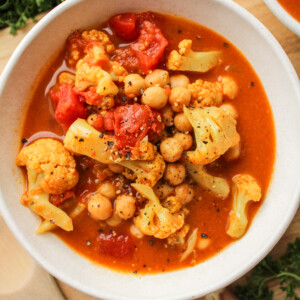
Cauliflower Chickpea Curry Stew
Ingredients
- 1 796 ml can diced tomatoes
- 1 398 ml can coconut milk
- 1 398 ml can chickpeas, drained and rinsed
- 1 head cauliflower, ~6 cups, chopped into bite size pieces
- 1 cup vegetable broth
- ½ medium white onion, diced
- 2 tbsp olive oil
- 3 cloves garlic, minced
- 1 tbsp tomato paste
- 1 tbsp curry powder
- ½ tbsp cumin
- 1 tsp paprika
- ½ tsp chili powder
- ½ tsp fresh ginger, minced
- ¼ tsp each salt and pepper
Instructions
- In a large pot over medium heat, add olive oil, garlic and onion and sauté for 2-3 minutes or until fragrant.
- Add the chopped cauliflower, curry powder, cumin, paprika, chili powder and fresh ginger and stir well. Cook for another 2-3 minutes.
- Pour in the coconut milk, diced tomatoes, vegetable broth and tomato paste. Stir well. Bring the mixture to a boil and then reduce the heat to medium-low and simmer for 10 minutes, or until the cauliflower is cooked through.
- Stir in the chickpeas and season with salt and pepper.
- Serve over rice and top with parsley, cilantro or your preferred herb and enjoy!
Notes
Substitutions and add-ins
- White beans, lentils, other legumes
- If you prefer an alternative bean to chickpea, consider adding white beans or lentils instead. Just make sure to drain and rinse the beans to remove the sodium before adding them to the stew.
- Chicken or beef stock
- You can easily swap out vegetable stock for either of these options! However, keep in mind that this substitution would result in a non-vegetarian meal.
- Full fat coconut milk
- I prefer to use low fat or lite coconut milk because it contains less saturated fat compared to full fat coconut milk. However, if this isn’t a concern for you and you would rather a creamier stew, you can use a full fat product.
- Red bell pepper
- Adding a bell pepper when the cauliflower is added would be a great way to increase the vitamin C content.
- Lime juice
- This stew already provides an acidic undertone with the tomatoes but if you would like a fresh citrusy bite, feel free to add a squeeze of fresh lime juice when serving.
- Fresh cilantro, parsley or basil
- I love to top this stew with a fresh herb. Feel free to choose your favourite.

Pingback: Sweet Potato and Lentil Peanut Stew - All Nutrition
Pingback: Vegetarian Lentil Bolognese - All Nutrition
Pingback: Vegetarian Lentil Bolognese - All Nutrition
Pingback: How Much Fibre Do You Need? - All Nutrition